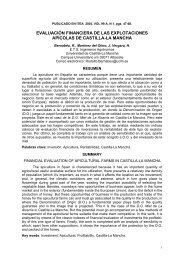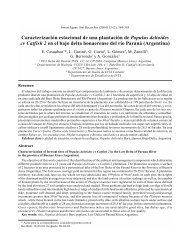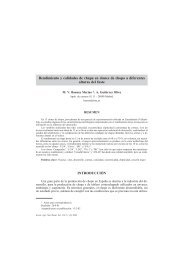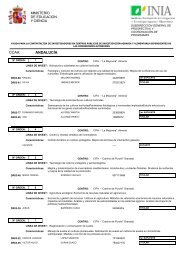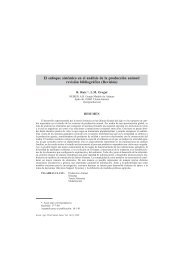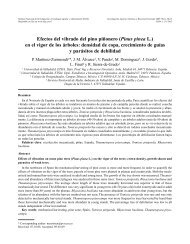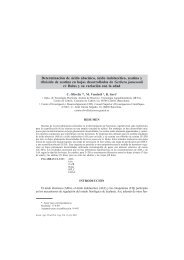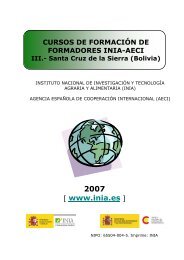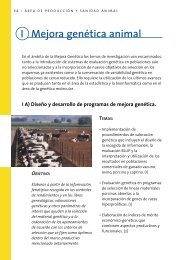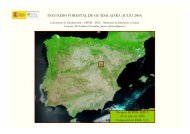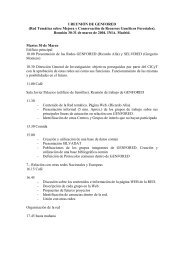Status of medicinal and aromatic plants in - Inia
Status of medicinal and aromatic plants in - Inia
Status of medicinal and aromatic plants in - Inia
You also want an ePaper? Increase the reach of your titles
YUMPU automatically turns print PDFs into web optimized ePapers that Google loves.
146<br />
WORKING GROUP ON MEDICINAL AND AROMATIC PLANTS: FIRST MEETING<br />
Research<br />
Molecular tools for determ<strong>in</strong><strong>in</strong>g genetic variability 21<br />
Branka Javornik<br />
Centre for Plant Biotechnology <strong>and</strong> Breed<strong>in</strong>g, Biotechnical Faculty, Ljubljana<br />
This presentation deals with modern approaches <strong>in</strong> determ<strong>in</strong><strong>in</strong>g genetic variability, <strong>in</strong> which<br />
three categories <strong>of</strong> genetic markers are applied – morphological, biochemical <strong>and</strong> molecular.<br />
Morphological markers (such as plant height, leaf shape, colour, etc.) are among the oldest<br />
markers used <strong>in</strong> the evaluation <strong>of</strong> genetic variability. However, they are not sufficiently<br />
specific <strong>and</strong> <strong>in</strong>formative because different gene expression <strong>in</strong> different environments causes<br />
wide variability <strong>of</strong> phenotypic characters <strong>in</strong> <strong>in</strong>dividuals. Similarly, biochemical markers<br />
(such as album<strong>in</strong> content, isoenzymes or essential oil contents <strong>in</strong> an <strong>in</strong>dividual organism) can<br />
be considered to be non-specific due to the wide variability <strong>of</strong> biochemical characters, which<br />
are strongly <strong>in</strong>fluenced by an <strong>in</strong>dividual's environment.<br />
The development <strong>of</strong> recomb<strong>in</strong>ant DNA <strong>in</strong> the 1980s enabled the development <strong>and</strong> use <strong>of</strong><br />
molecular markers, thus provid<strong>in</strong>g a modern tool for determ<strong>in</strong><strong>in</strong>g genetic variability.<br />
Molecular markers show variability among <strong>in</strong>dividuals on the DNA level, which is not<br />
<strong>in</strong>fluenced by the environment.<br />
Different genetic markers (e.g. RFLP, AFLP, RAPD, SSR, SCAR) have different properties,<br />
(dom<strong>in</strong>ant <strong>and</strong> co-dom<strong>in</strong>ant markers, different coverage <strong>of</strong> the genome) <strong>and</strong> different<br />
advantages <strong>and</strong> disadvantages (e.g. specificity, cost, ease <strong>of</strong> analytical <strong>in</strong>terpretation <strong>of</strong> the<br />
result<strong>in</strong>g data). However, they are highly <strong>in</strong>formative about genetic variability among<br />
<strong>in</strong>dividuals, populations <strong>and</strong> cultivars. Their use is universal for all organisms. Molecular<br />
markers can be considered to be essential tools <strong>in</strong> cultivar identification (DNA typ<strong>in</strong>g),<br />
assessment <strong>of</strong> genetic variability <strong>and</strong> relationships, management <strong>of</strong> genetic resources <strong>and</strong><br />
biodiversity, studies <strong>of</strong> phylogenetic relationships <strong>and</strong> <strong>in</strong> genome mapp<strong>in</strong>g.<br />
The ma<strong>in</strong> aim <strong>of</strong> the management <strong>of</strong> genetic resources is to ensure that as much as<br />
possible <strong>of</strong> the exist<strong>in</strong>g genetic diversity <strong>of</strong> species is conserved. The effectiveness <strong>of</strong> this<br />
depends to a large extent on the genetic <strong>in</strong>formation available on the germplasm under<br />
study.<br />
Molecular markers provide genetic <strong>in</strong>formation <strong>of</strong> direct value for ex situ <strong>and</strong> <strong>in</strong> situ<br />
conservation. For ex situ conservation, the acquisition <strong>of</strong> data on the diversity <strong>of</strong> collections<br />
is important. Molecular markers can be used (i) to identify valuable genetic variation that is<br />
under-represented <strong>in</strong> a collection sample; (ii) to identify duplicate accessions <strong>and</strong> to monitor<br />
changes <strong>in</strong> genetic structure as accessions are generated; (iii) to assess the available genetic<br />
diversity for each species; (iv) to provide more accurate <strong>and</strong> detailed <strong>in</strong>formation than is<br />
available us<strong>in</strong>g classical phenotypic data; (v) to identify traits <strong>and</strong> types quickly.<br />
On a more fundamental level, molecular marker <strong>in</strong>formation may lead to the further<br />
identification <strong>of</strong> useful genes conta<strong>in</strong>ed <strong>in</strong> a collection. Molecular data on diversity may<br />
provide essential <strong>in</strong>formation to develop core collections that accurately represent the entire<br />
collection. For ex situ conservation, molecular markers may be used <strong>in</strong>: the determ<strong>in</strong>ation <strong>of</strong><br />
identity <strong>and</strong> similarity <strong>of</strong> accessions or <strong>in</strong>dividuals; the measurement <strong>of</strong> the structure <strong>of</strong><br />
diversity among <strong>in</strong>dividuals, accessions, populations <strong>and</strong> species; <strong>and</strong> the detection <strong>of</strong><br />
particular allele or nucleotide sequences <strong>in</strong> a taxon, genebank accession or <strong>in</strong> situ population.<br />
21 Summary <strong>of</strong> the presentation made at the meet<strong>in</strong>g.




